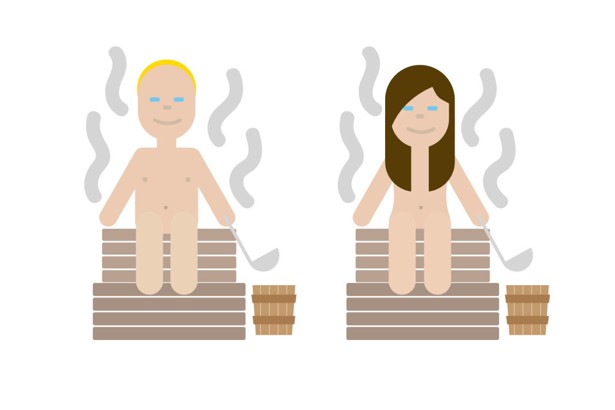
Next month, the nation of Finland will mark Advent in a historically unusual way.
Every day from December 1 to Christmas Eve, Finland will post a new small, evocative icon of Finnishness to a special website. One image will depict a pale Finn sweating in a sauna (see above). Another, a doom-metal headbanger. A third, a Nokia 3310, the flagship phone of that old Finnish mobile giant.
An article on This is Finland, an official government site, brags that there will be more than 30 of these icons across the 24 days. It adds: “If you wondered, why we only have 24 hatches on the calendar instead of 25, it is because Christmas is celebrated in Finland on the Christmas Eve, not Christmas Day.”
But then it goes a step too far. Says the online liason of Laplanders: “Finland is the first country in the world to launch its own country-themed emoji sticker set.”
Finland is, to be clear, a wonderful country. But it has called these fun proprietary icons emoji. And about this, it could not be more wrong.
Emoji, like many other mobile innovations, emerged in Japan. They were developed first by private phone companies there—small images that could travel along with text and accent a message. They are a continuation, in many ways, of emoticons. (In Japan, emoticons also grew into kaomoji, which are more complex arrangements of letters and numbers, like ¯\_(ツ)_/¯.)
In 2009, Apple adopted emoji for its iPhone, and Google soon followed for its Android system. Emoji became familiar to U.S. users. But accompanying the Americanization of emoji was the standardization of emoji. Instead of existing as images that traveled with text, emoji became symbols specified by the Unicode Consortium. A committee led by Apple and Google now considers new additions to the emoji standard every year.
Those emoji—the ones specified by the Unicode Consortium—are, to my mind, the only real emoji left in the world. That’s because now-standardized emoji act like online text: They’re an open, readable format that can be deciphered by anyone with an emoji font. Emoji-as-images, meanwhile, like the Finns are doing, require someone to download pictures whenever they want to read a paragraph. It’s the difference between having a paragraph of text you can highlight, copy, paste, and edit and… having a screenshot of text.
Finland’s emoji, then, are not real emoji. They are something far more nefarious: Efauxji. They are mere images masquerading as glyphs, pretenders to the emoji throne.
The scourge of efauxji is not limited to Scandinavian nationalism. Earlier this month, Dove—not a bird, but the soap company—announced that it too had created new emoji. Representatives of the company had determined that all emoji were straight-haired (this, by the way, is true, but beside the point) and had decided to amerliorate this personally with “curly-haired emoji.” It too released images that, while they can be typed on a keyboard, are not standard. They are just little pictures.
In 1823, President James Monroe famously declared that the New World was closed to Old World colonization and interference. Let us draw the analogy: Now the emoji frontier is closed as well. Once it was a wide-open time of emoji experimentation—an era when emoji could be images. Now we live in a more rationalized time. Let us foreclose the word “emoji” off to companies seeking to make emoji more commercialier than they already are. Let us call these efauxji by their real name: fake AIM icons.